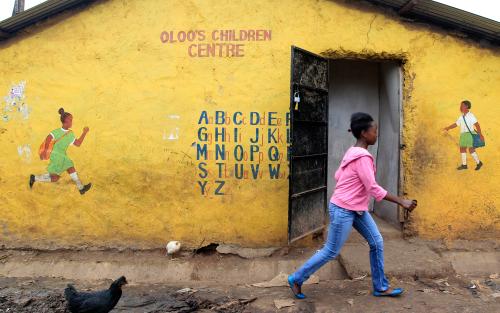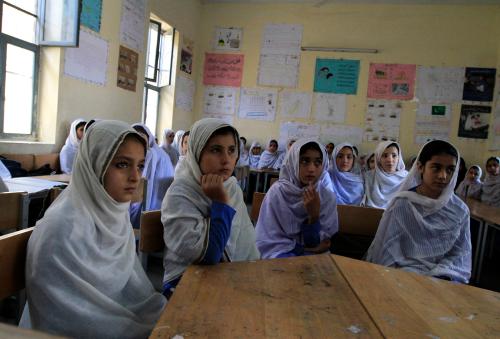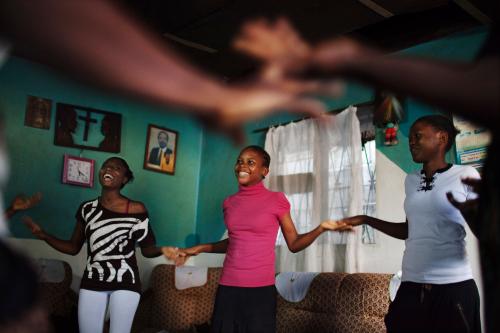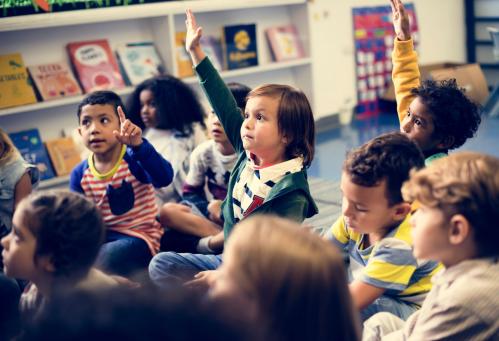Something we have been writing a lot about this year is the need to lift up the global ambition for girls’ education and coalesce behind an agenda that includes but goes beyond gender parity in school. For the past two decades, getting girls and boys enrolled in primary and secondary school in equal numbers has been a goal taken up by those working towards the world’s Education for All and Millennium Development goals. The progress toward these goals has been great. In developing countries in 1990, there were just 89 girls for every 100 boys enrolled in primary school, and today it is nearly equal at 98 girls per 100 boys.
This does not mean, however, the end of the story for girls’ education. Tracking the numbers of girls versus boys enrolling in school is crucial but there is a lot that gender parity does not tell us. While girls may enroll or enter school in equal numbers as boys, they may fail to learn well while there, be exposed to violence and harassment, and drop out before they finish. Conversely, gender parity data can also improve not because more girls are enrolling in school but because more boys are dropping out.
During our June conference “Celebrating Progress, Remaining Steadfast, and Asking What’s Next in Girls’ Education,” we put forward the idea that there are a handful of “second generation” girls’ education issues around which there is evidence of compelling need and a next global agenda can be built. In dialogue with many partners, including members of the United Nations Girls’ Education Initiative and girls’ education networks across Asia and Africa, we developed five main priorities that can help lift up the global ambition for girls: access, safety, quality, transitions, and leadership. Girls’ education advocates have long worked on one or more of these priorities in different parts of the world, but together as a global agenda they raise our ambition from gender parity to the hope that girls everywhere can leave school with the skills they need for their lives and livelihoods.
Today, at the Clinton Global Initiative, a group of more than 30 partners—from governments, NGOs, foundations, and the private sector—have come together to announce the work they are committing to doing on these second generation girls education issues. This group, named Girls CHARGE (Collaborative for Harnessing Ambition and Resources for Girls’ Education), has organizations both big and small, including local girls’ education leaders from countries such as Pakistan, Nigeria, and Malawi. This is especially important because global advocacy on the second generation girls’ education issues must be married with concrete actions on the ground. Now, perhaps more than ever before, the solutions to the five priority issues will be highly contextual depending on where girls’ live. In many ways the girls that need better opportunities to learn—from sub-Saharan Africa to Southwest Asia—are the ones that are the most marginalized and will best be reached by local social entrepreneurs and leaders.
Watch the announcement of Girls CHARGE here:
Below is a summary of the second generation girls’ education issues which are so important for lifting up the global ambition for girls:
#1: ACCESS. Ensuring that girls enter and stay in school through secondary education. There has been tremendous progress in getting equal numbers of girls as boys enrolled in primary school over the last 20 years, but as we showed on Monday the data shows there are still many areas where girls are severely disadvantaged, particularly in “hotspots” like sub-Saharan Africa and South and West Asia. These girls face unsafe schools and high levels of child marriage, and the disadvantages they face of being poor and living in rural areas are exacerbated by being a girl. While much attention has been paid to getting girls into primary school, it is crucial to consider the whole pipeline for these girls, from starting school on time in early childhood through completing secondary.
#2: SAFETY. Ensuring that schools are safe and facilities are girl-friendly. There are at least 15 countries where girls and their right to an education have been specifically attacked since 2009. This ranges from Afghanistan and Pakistan where schools, teachers, parents and girls have been threatened or attacked in order to prevent girls from being educated, to Colombia, Libya and the Democratic Republic of Congo, where girls have been raped and harassed by armed groups in and on the way to school. In many more countries, schools are rife with sexual harassment and assault from teachers and fellow students for girls who attend. The lack of a safe space to learn leads to low attendance and low levels of learning for girls. As the type of violence and underlying causes vary so widely in each community, the need for localized and sustained solutions is crucial to make sure no girl has to risk her life or health just to go to school.
#3: QUALITY LEARNING. Improving the quality of learning opportunities for girls. Even when girls are in school, and able to attend safely, they often face such poor quality that they learn little. Studies have shown that children in the developing world, even when they attend school, are far behind their peers in rich countries. In North America and Western Europe, 96 percent of children reach fourth grade and learn basic reading skills. However, in sub-Saharan Africa just 40 percent and in South and West Asia only 33 percent meet this achievement level. In Malawi, just 8 percent of students met minimum levels of math skills. While this learning crisis affects boys and girls alike, disadvantaged children are farthest behind, with gender exacerbating low levels for girls. For instance in Benin, only 6 percent of poor girls compared to 60 percent of rich boys attained basic numeracy skills. Improving quality is not a problem that can be solved by one simple “silver bullet” solution, especially to reach the most marginalized poor girls effectively, and each school faces its own unique set of problems.
#4: TRANSITIONS. Supporting girls’ transition from secondary school to post-secondary school and the workforce. Getting into and finishing school is just the beginning of a girl’s life, and in the end she will benefit most from her education if it translates into a productive life after secondary school. Unfortunately, too often young women and fail to transition into careers or higher education after finishing school. However simply improving enrollment in school is not the solution for many countries. In Jordan, for example, girls and boys are in school in equal numbers, yet there are just 23 women for every 100 men participating in the labor force. Globally, women are more likely to be employed in “vulnerable” jobs that lack stability. And while in many countries, women now outnumber men in higher education, in regions where women are most disadvantaged like sub-Saharan Africa they still lag behind. And so tailored solutions that address the specific issues of culture, the labor market, and what role education can play in each context will be critical to making sure millions of young women prosper after their education is complete.
#5: LOCAL LEADERSHIP. Supporting leaders in developing countries to help catalyze change in girls’ education. However, this new set of challenges facing girls and women in developing countries calls for much more localized solutions that take into account the unique context of each country and community struggling to provide all girls a safe and high-quality education. The 2012 World Development Report on Gender Equality and Development found that education for women has improved tremendously in areas where there was a single barrier preventing girls from attending school. Moving forward, the report emphasizes, the remaining challenges require removing several barriers that are more complex and intertwined. To accomplish this, we need to support local leaders who know their communities and the barriers girls there face, but who lack the resources and training to be successful at scale. Forming a funding mechanism for such local leaders is an idea we laid out earlier this year, and a crucial piece for tackling the next generation of girls’ education issues.








Commentary
A Commitment to Raise the Global Ambition for Girls’ Education
September 24, 2014